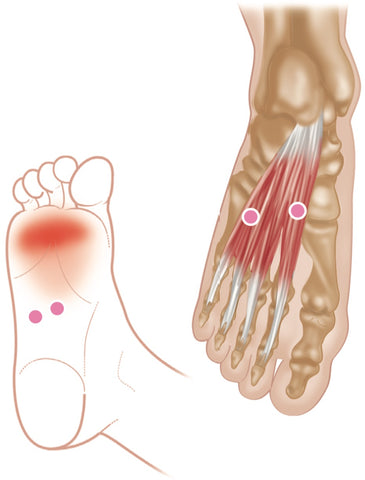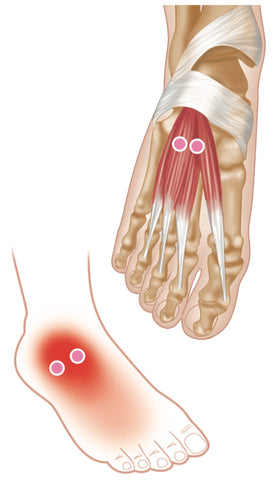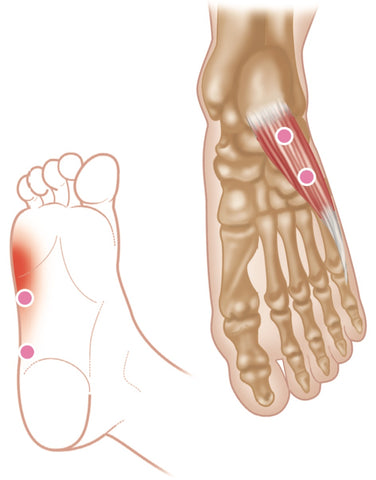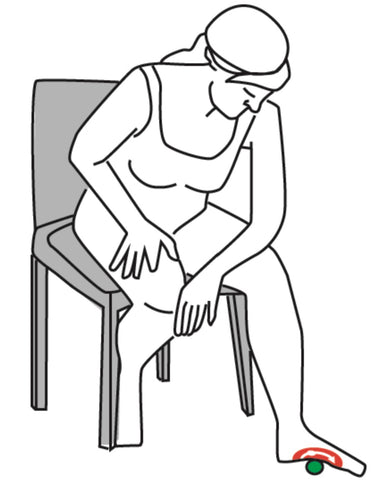Trigger Point Therapy - Superficial Muscles of the Foot

Abductor Hallucis - Common Trigger Point Sites and Referred Pain Pattern
Foot pain can have a profound impact on quality of life.
Half of all adults say that foot pain has restricted their activities—like walking, exercising, working, or playing with grandchildren—in some way. For those with chronic foot pain, that number jumps to 83 percent. People say they would exercise more (39 percent) and participate in more activities (41 percent) if it weren’t for their foot pain.
We depend on the superficial muscles of the foot for almost constant functional movement, and sometimes subject them to punishment without too much thought, until they start to hurt! These muscles include the abductor hallucis, flexor digitorum brevis, abductor digiti minimi, extensor digitorum brevis.

Flexor Digitorum Brevis - Common Trigger Point Sites and Referred Pain Pattern
Trigger Points and Referred Pain Patterns
Trigger Points in the superficial muscles of the foot are incredibly common and trigger point therapy can often provide both short and long term relief. The most common referred pain maps that we see, are:
Abductor hallucis: medial heel pain, radiating along the medial border of the foot.
Flexor digitorum brevis: pain in the plantar aspect of the foot beneath (2nd, 3rd, and 4th) metatarsal heads.
Abductor digiti minimi: pain in plantar aspect of the foot beneath the 5th metatarsal head.
Extensor digitorum brevis: cause a strong oval overlapping zone of pain (4–5 cm) in the lateral dorsum of the foot just below the lateral malleolus.

Extensor Digitorum Brevis - Common Trigger Point Sites and Referred Pain Pattern
Trigger Point Indications
Indications commonly include foot pain (dorsal/plantar); “soreness” on walking together with “aching” at rest; pain on tiptoes, when weight bearing, or initial standing from sitting; toe cramps; and patchy foot numbness.
Causes
Arthritic toes, poor footwear (heels) or orthotics, sports (e.g. swimming, walking, jogging, running, sprinting), hypomobile ankles, toe clawing, trauma.
Differential Diagnosis
Avulsion fracture of styloid process. Hallux valgus. Flat footed. Hallux rigidus or hypermobility. Metatarsalgia. Hammer/claw toe deformity. Heel spur. Stress (march) fracture. Compartment syndromes. Varus and valgus of foot.

Abductor Digiti Minimi - Common Trigger Point Sites and Referred Pain Pattern
Connections
Plantar interossei, quadratus plantae, adductor hallucis, extensor digitorum longus/brevis, flexor digitorum brevis, hip/knee/ankle/ foot mechanics, extensor hallucis brevis, abductor hallucis.
Origin
Abductor hallucis: tuberosity of calcaneus. Flexor retinaculum. Plantar aponeurosis.
Flexor digitorum brevis, abductor digiti minimi: tuberosity of calcaneus. Plantar aponeurosis. Adjacent intermuscular septa. Extensor digitorum brevis: anterior part of superior and lateral surfaces of calcaneus. Lateral talocalcaneal ligament. Inferior extensor retinaculum.
Insertion
Abductor hallucis: medial side of base of proximal phalanx of great toe.
Flexor digitorum brevis: middle phalanges of 2nd to 5th toes. Abductor digiti minimi: lateral side of base of proximal phalanx of 5th toe. Extensor digitorum brevis: base
of proximal phalanx of great toe. Lateral sides of tendons of extensor digitorum longus to 2nd, 3rd, and 4th toes.
Action
Abductor hallucis: abducts and helps flex great toe at metatarsophalangeal joint. Antagonist: adductor hallucis. Flexor digitorum brevis: flexes all joints of lateral four toes except distal interphalangeal joints. Antagonists: extensor digitorum longus, extensor digitorum brevis. Abductor digiti minimi: abducts 5th toe. Antagonist: flexor digiti minimi brevis.
Extensor digitorum brevis: extends joints of medial four toes. Antagonists: flexor digitorum longus, flexor digitorum brevis.
Nerve
Abductor hallucis, flexor digitorum brevis: medial plantar nerve, L4, 5, S1.
Abductor digiti minimi: lateral plantar nerve, S2, 3. Extensor digitorum brevis: deep bular (peroneal) nerve, L4, 5, S1.
Basic Functional Movement
Examples: facilitating walking; helping foot stability and power in walking and running; helping to gather up material under foot by involving great toe.

Pressure Tools and hard Balls Can be Useful
Self Managed Care & General Advice
Self-pressure and/or pressure tools are recommended, as these muscles are superficial and respond well to pressure.
Gait/posture analysis. Footwear. Orthotics. Home stretching using golf/tennis ball or rolling pin. Use a small heel. Warmth and stretch.
Find a Trigger Point Professional in your area
Nationally Accredited Home-Study Courses
This trigger point therapy blog is intended to be used for information purposes only and is not intended to be used for medical diagnosis or treatment or to substitute for a medical diagnosis and/or treatment rendered or prescribed by a physician or competent healthcare professional. This information is designed as educational material, but should not be taken as a recommendation for treatment of any particular person or patient. Always consult your physician if you think you need treatment or if you feel unwell.
About Niel Asher Education
Niel Asher Education (NAT Global Campus) is a globally recognised provider of high-quality professional learning for hands-on health and movement practitioners. Through an extensive catalogue of expert-led online courses, NAT delivers continuing education for massage therapists, supporting both newly qualified and highly experienced professionals with practical, clinically relevant training designed for real-world practice.
Beyond massage therapy, Niel Asher Education offers comprehensive continuing education for physical therapists, continuing education for athletic trainers, continuing education for chiropractors, and continuing education for rehabilitation professionals working across a wide range of clinical, sports, and wellness environments. Courses span manual therapy, movement, rehabilitation, pain management, integrative therapies, and practitioner self-care, with content presented by respected educators and clinicians from around the world.
Known for its high production values and practitioner-focused approach, Niel Asher Education emphasises clarity, practical application, and professional integrity. Its online learning model allows practitioners to study at their own pace while earning recognised certificates and maintaining ongoing professional development requirements, making continuing education accessible regardless of location or schedule.
Through partnerships with leading educational platforms and organisations worldwide, Niel Asher Education continues to expand access to trusted, high-quality continuing education for massage therapists, continuing education for physical therapists, continuing education for athletic trainers, continuing education for chiropractors, and continuing education for rehabilitation professionals, supporting lifelong learning and professional excellence across the global therapy community.

Continuing Professional Education
Looking for Massage Therapy CEUs, PT and ATC continuing education, chiropractic CE, or advanced manual therapy training? Explore our evidence-based online courses designed for hands-on professionals.



















